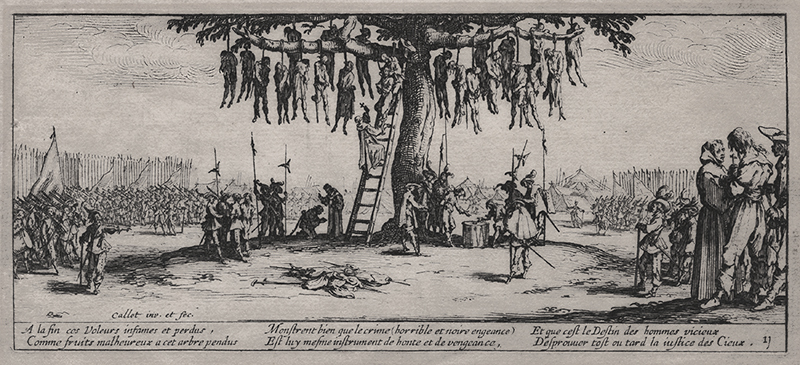
19th, 20th & 21st Century Fine Prints
707-546-7352 · fax 707-546-7924 · web: www.annexgalleries.com · email: artannex@aol.com
The Hanging - pl. 11, "The Miseries and Misfortunes of War" by Jacques Callot

The Hanging - pl. 11, "The Miseries and Misfortunes of War"
Jacques Callot
The Hanging - pl. 11, "The Miseries and Misfortunes of War"
Jacques Callot
1592 - 1653 (biography)French printmaker Jacques Callot created the eighteen-plate series, titled in full as Les Grandes Miseres et les Malheurs de la Guerre in 1633 on the heels of his smaller, six-plate series executed the year prior - now assumed by Callot scholars to be an abandoned precursor to the larger masterpiece. Considered the first anti-war series by a European artist, Les Grande Miseres... is an unflinching, honest portrayal of the fallout of war, drawn out in eighteen plates like a chaptered story.
"The Hanging," or "La Pendaison," is the 11th image and the most famous in the series. In it, a group of villagers, whose homes have been destroyed by pillaging soldiers following an unnamed war, are in the process of stringing up the only soldiers they could capture - the injured or ill - as onlookers stand by. There is no pretense of blame on the part of the artist. He has only presented a plain and powerful visual description of the senselessness of war.
Many series dealing with this subject have since gained as much if not more notice than Callot's, yet his is considered the first to tackle the subject and to have abstained from allegory. It is assumed to have been a major influence on future artists, especially Goya. This plate is from the second state with the plate number in the lower right and the text, attributed to Michel de Marolles (French: 1600 - 1681), monk, translator, and collector of Old Master prints known for his collection of 123,000 pieces.
